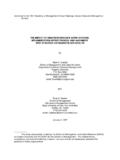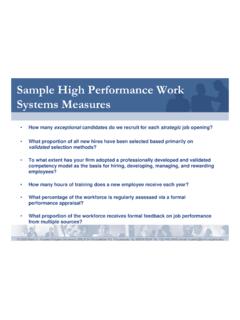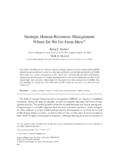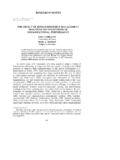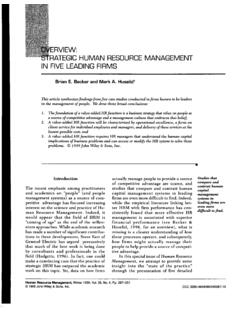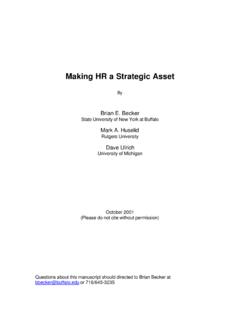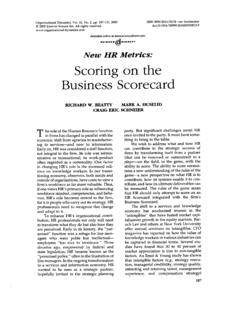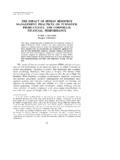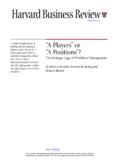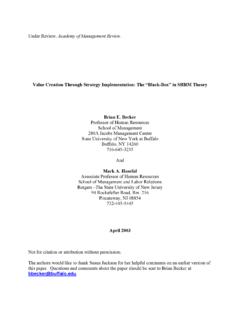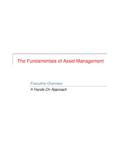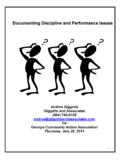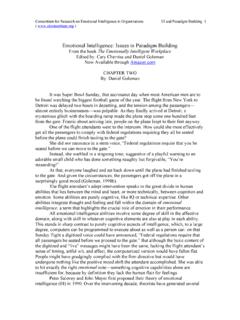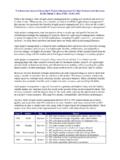Transcription of TECHNICAL AND STRATEGIC HUMAN RESOURCE …
1 Academy of management Journal1997, Vol. 40, No. 1, 171 AND STRATEGIC HUMANRESOURCE management EFFECTIVENESS ASDETERMINANTS OF FIRM PERFORMANCEMARK A. HUSELIDR utgers UniversitySUSAN E. JACKSONRANDALL S. SCHULERNew York UniversityWe evaluated the impact of HUMAN RESOURCE (HR) managers capabili-ties on HR management effectiveness and the latter s impact on corpo-rate financial performance. For 293 firms, effectiveness was asso-ciated with capabilities and attributes of HR staff. We also found rela-tionships between HR management effectiveness and productivity, cashflow, and market value. Findings were consistent across market andaccounting measures of performance and with corrections for is broad agreement that a STRATEGIC approach to HUMAN resourcemanagement (HRM) involves designing and implementing a set of internallyconsistent policies and practices that ensure a firm's HUMAN capital (em-ployees' collective knowledge, skills, and abilities) contributes to theachievement of its business objectives (Baird & Meshoulam, 1988; Jackson &Schuler, 1995; Schuler & Jackson, 1987).
2 Fundamental to the STRATEGIC HRMperspective is an assumption that firm performance is influenced by the setof HRM practices firms have in place. Recent empirical evidence supportsthis basic assumption (Arthur, 1994; Cutcher-Gershenfeld, 1991; Huselid,1995; Huselid & Becker, 1996; MacDuffie, 1995).Paradoxically, the preliminary empirical research, which established arelationship between HRM policies and practices and firm performance,made little distinction between policies and practices that reflect the moretraditional, or TECHNICAL , personnel perspective and those that reflect theadoption of the STRATEGIC HUMAN RESOURCE management perspective.
3 More-over, prior work has not considered the types of capabilities of HUMAN re-sources staffs associated with the effective implementation of these twotypes of HRM policies and this article, we attempt to improve upon the prior empirical literatureon this topic by focusing on the impact of overall HRM quality on firmperformance. We first develop the argument that HRM effectiveness, whichWe are grateful to IBM and Towers-Perrin for their support of this of management JournalFebruaryincludes the delivery of high-quality TECHNICAL and STRATEGIC HRM activities,will be reflected in valued firm-level outcomes.
4 We then assert that twotypes of HRM staff capabilities will have a significant impact on the effectivemanagement of firms' HUMAN capital. To study the impact of HRM effective-ness and HUMAN resources staff capabilities on valued firm-level outcomes employee productivity and corporate financial performance we examineda large sample of firms drawn from a wide range of industries. Finally, weconsider two important methodological issues that could bias our results: (1)the potential endogeneity of firm profitability and managerial assessments ofHRM effectiveness and (2) survey response BACKGROUND AND HYPOTHESEST echnical and STRATEGIC HRM EffectivenessInstitutional theorists view organizations as entities that seek approvalfor their activities in socially constructed environments.
5 Conformity to ex-pectations for behavior is the means through which firms gain legitimacyand acceptance in the eyes of stakeholders. Consequently, over long periodsof time, HRM activities of interest to these stakeholders spread throughoutthe population of firms. External stakeholders whose expectations are par-ticularly relevant in shaping TECHNICAL HRM activities include the govern-ment, which regulates a wide range of employment practices, and variousprofessional organizations (Baron, Jennings, & Dobbin, 1988; Tolbert &Zucker, 1983). The expectations of these stakeholders tend to be similar forall firms, and all firms feel some pressure to conform.
6 In addition, key in-ternal stakeholders (line managers and executives) prefer high-quality tech-nical HRM activities (Tsui, 1987). TECHNICAL HRM activities that have beenincreasingly regulated through stakeholder expectations include recruiting,selection, performance measurement, training, and the administration ofcompensation and benefits. Reflecting the high level of knowledge and ex-pertise associated with these activities are occupational specializations forthose who carry out these activities, professional criteria for judging theeffectiveness of these activities, and professional certification programs forthose who carry them out (Baron et al.)
7 , 1988).In contract to TECHNICAL HRM activities, STRATEGIC HRM activities arerelatively recent innovations, so stakeholders are not yet likely to hold strongexpectations or put pressure on organizations to adopt these practices ( , 1993; Wright & McMahan, 1992). Although scholars have yet to reachagreement about how best to define STRATEGIC HUMAN RESOURCE management ,there is, nevertheless, broad agreement that it involves designing and imple-menting a set of internally consistent policies and practices that ensure afirm's HUMAN capital contributes to the achievement of its business objec-tives (Baird & Meshoulam, 1988; Jackson & Schuler, 1995; Schuler & Mac-Millan, 1984).
8 During the past decade, compensation systems in particularhave been studied as a way to deploy HRM systems strategically (Gerhart &1997 Huselid, Jackson, and Schuler173 Milkovich, 1992; Gomez-Mejia & Balkin, 1992). The STRATEGIC role of a firm'sHRM system has become the focus of empirical investigation somewhatmore recently (Jackson & Schuler, 1995). Other STRATEGIC HRM activities in-clude team-based job designs, flexible workforce, quality improvementpractices, employee empowerment, studies designed to diagnose a firm'sstrategic needs, and planned development of the talent required to imple-ment competitive strategy and achieve operational goals.
9 For these strategicHRM activities, there is little shared understanding about how to achieveeffective implementation, and there are few regulatory guidelines; in addi-tion, occupational specialization is not yet apparent. Given these conditions,effective STRATEGIC HRM activities should be relatively rare across a popula-tion of firms. Thus,Hypothesis 1: firms have achieved higher levels oftechnical HUMAN RESOURCE management effectiveness thanof STRATEGIC HRM Effectiveness and Firm PerformanceThe RESOURCE -based view of the firm suggests that a firm's pool of humancapital can be leveraged to provide a source of competitive advantage ( , 1991; Wright, McMahan, & McWilliams, 1992).
10 Assuming heteroge-neity among firms with respect to their HUMAN capital, competitive advan-tage is possible if a firm insures that its people add value to its productionprocesses and that its pool of HUMAN capital is a unique RESOURCE , bothdifficult to replicate and difficult to substitute for. HRM practices comprisethe many activities through which firms create HUMAN capital that meetsthese conditions. Specifically, firms can use TECHNICAL HRM activities toselect high-ability employees, whose talent is rare by definition (cf. Wright& McMahan, 1992), and to train employees so they have the unique skillsneeded.
